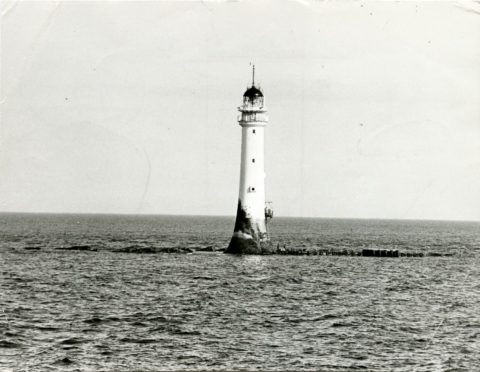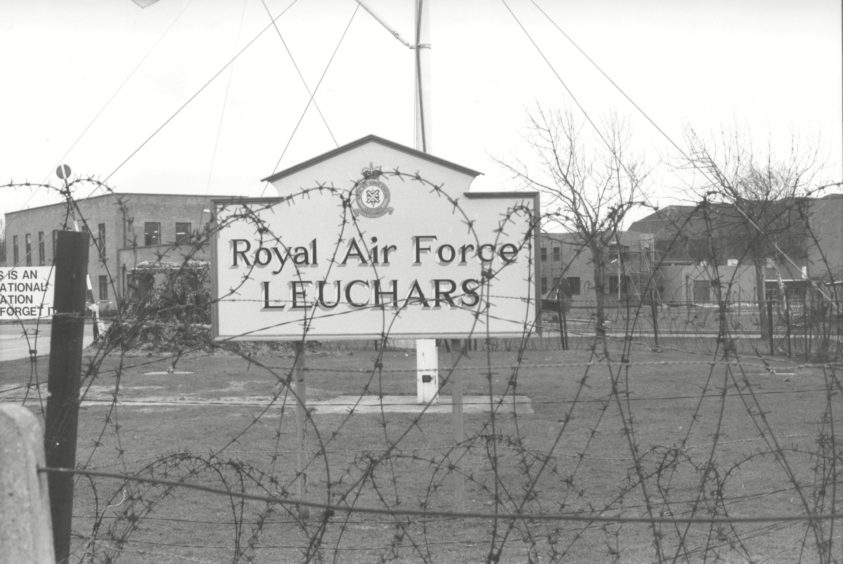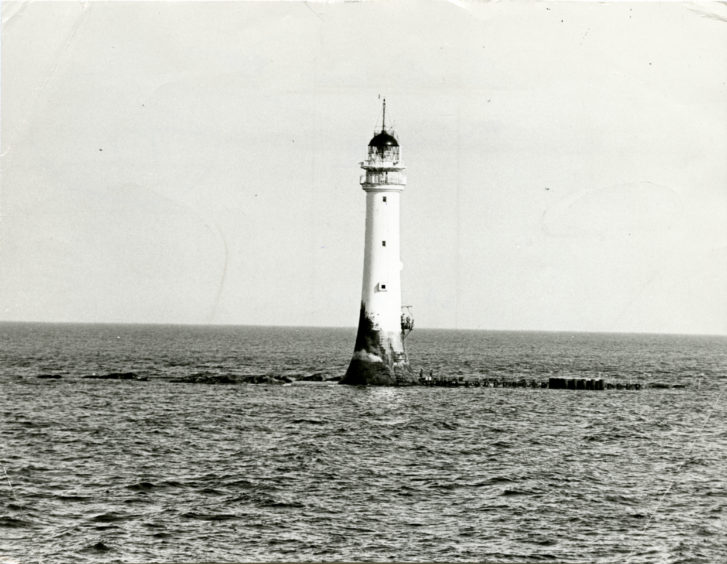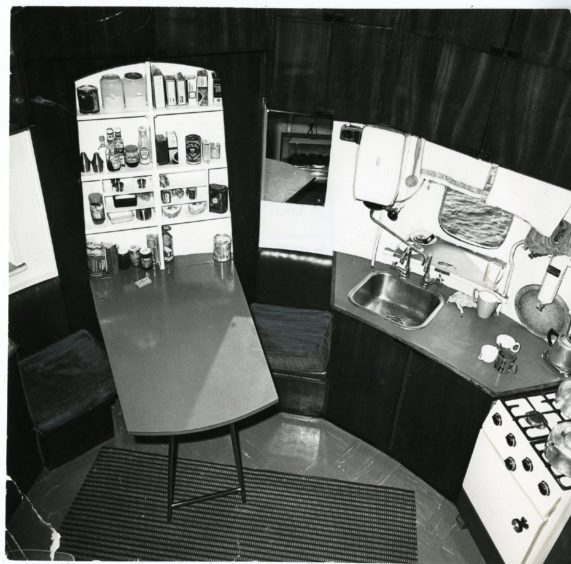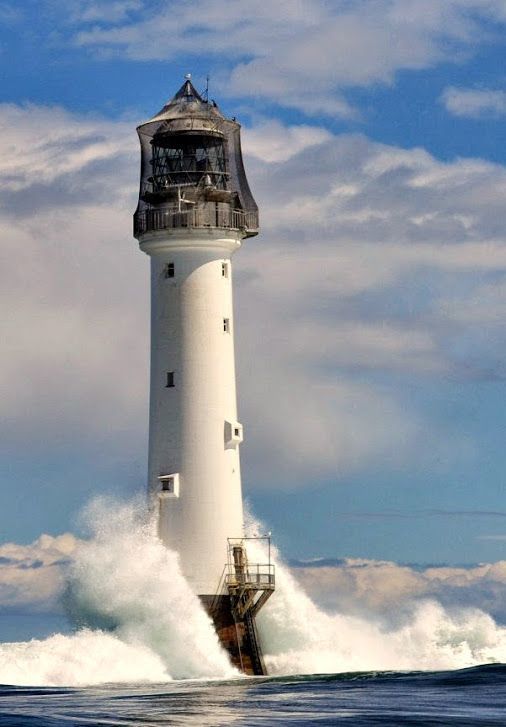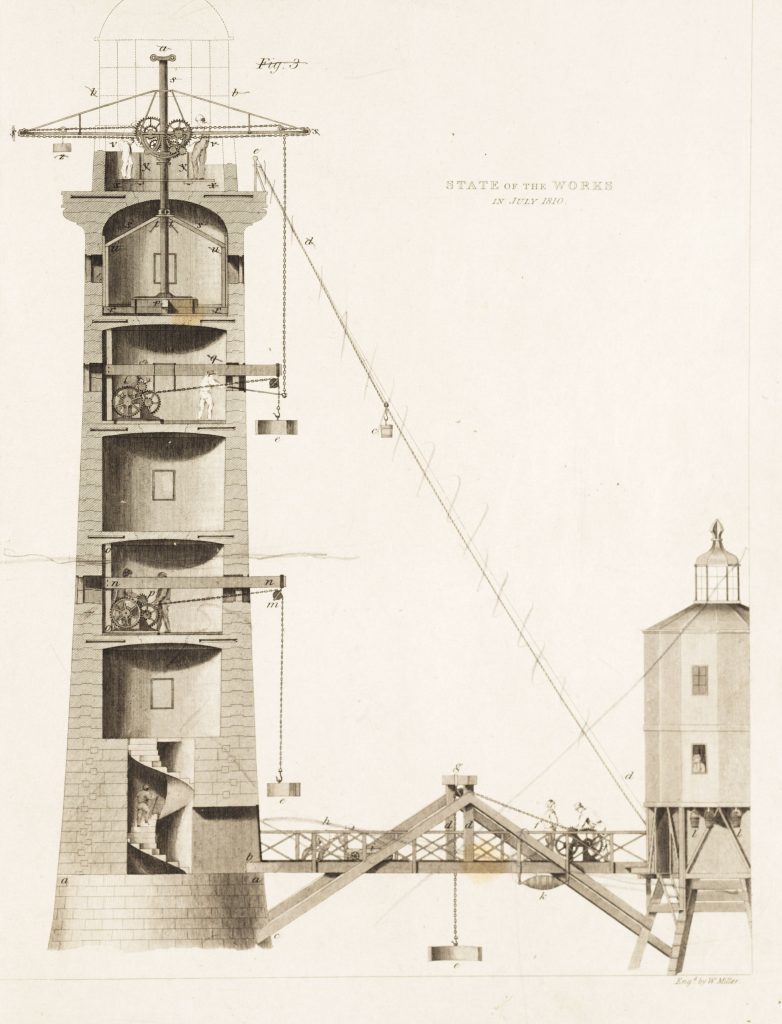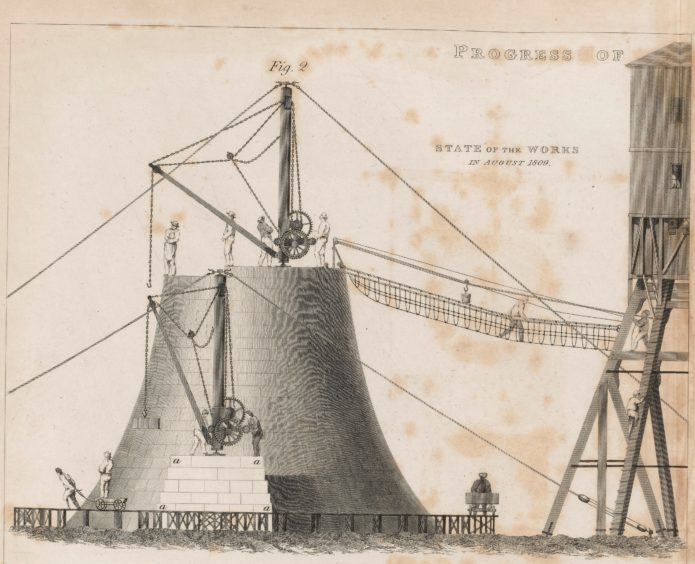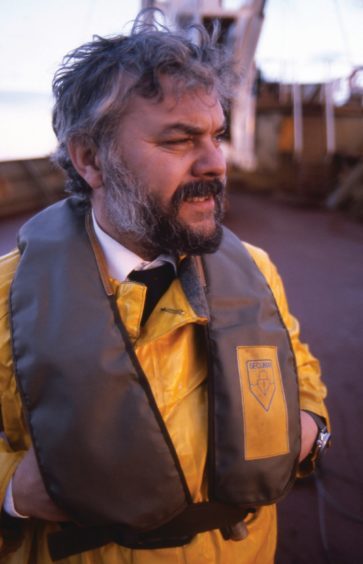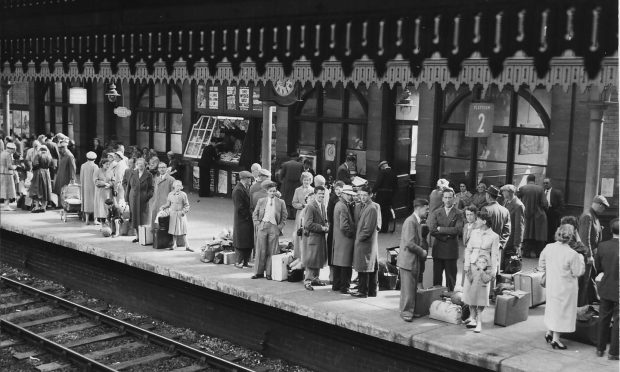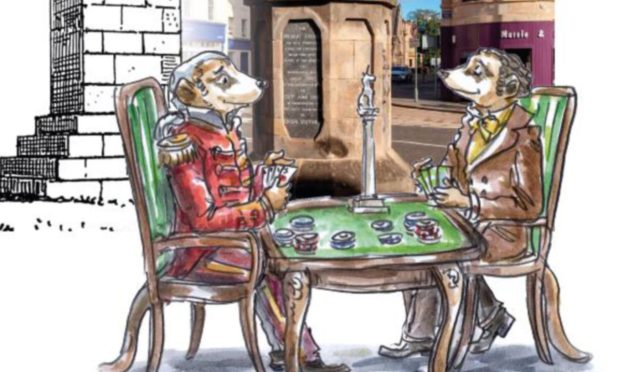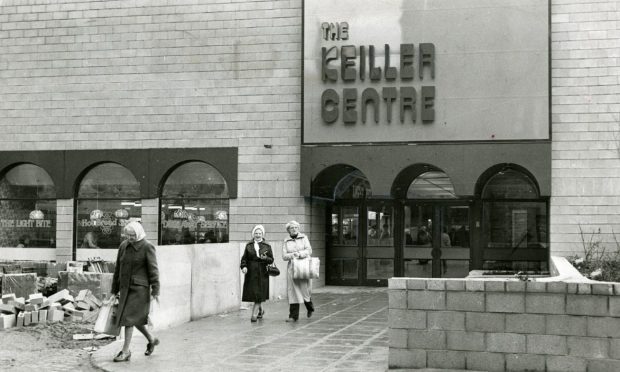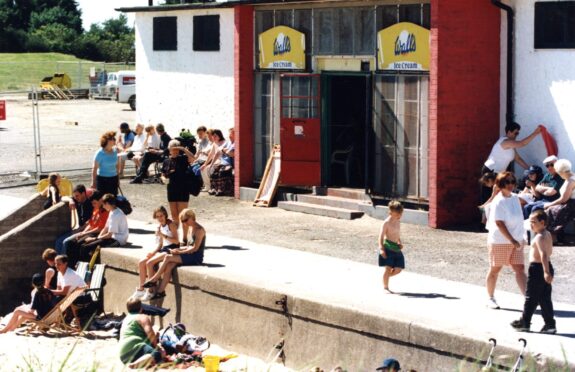A fatal helicopter crash 65 years ago marked a grim chapter in the history of the Bell Rock Lighthouse and cast a dark cloud over RAF Leuchars.
Flight Sergeant Percy Albert Beart, 33, and Sgt Edward Francis Hall, 31, perished when a friendly gesture turned to tragedy as they attempted to drop a bundle of newspapers and magazines for the lighthouse keepers on their temporary Alcatraz.
The lighthouse was damaged, including the loss of its light, which was probably the only time the light was not exhibited during its existence, except for periods during the war.
Inchcape Reef
The notorious Bell Rock is built 11 miles off the coast of Arbroath on the deadly Inchcape Reef, which has claimed countless vessels and lives.
Flt Sgt Beart and Sgt Hall were the crew of an RAF Bristol Sycamore which left RAF Leuchars at 9.35am on December 15 1955.
The helicopter circled the rock and the crew intended to make a drop, but as heavy seas were sweeping over the landing grating it was impossible for the keepers to go out.
The airmen then elected to lower what they had intended to deliver on the top of the dome, where the three keepers went to accept delivery.
Something went wrong around 10am and the keepers watched in horror as the helicopter plunged out of control towards them.
The keepers miraculously escaped uninjured but the helicopter struck the copper dome.
The impact ripped off a large section of the cast iron gutter surrounding the lantern and wrenched off the steel ladder between the balcony and the dome.
The helicopter demolished a number of plate glass lantern panes, distorting some of the bronze astragals, and carrying away handrails and other fittings, before crashing on the rock base of the tower 130 feet below.
It burst into flames and washed into the sea.
Rescue mission
Flt Sgt Beart could still be seen in the wrecked machine which was now partially submerged and being struck by the heavy seas.
The smallest of the three keepers fastened a life line round his middle while the other assistant held the rest of the line.
He then proceeded down the bronze ladder from the doorway, watched his chance between the oncoming seas, made a dive for it, and managed to enter the swaying wreck.
Unfortunately the airman had not survived the crash and there was nothing he could do except make his way back to the safety of the lighthouse.
A huge wave then swept over the reef and carried the wrecked helicopter away into deep water and it was never seen again.
The accident was witnessed by the crew of a second helicopter who immediately sent out a distress call and flew to the scene of the crash.
Three Ansons, one Chipmunk and two Sycamores, as well as two RAF rescue launches and three lifeboats searched the area.
Around 2pm the Coastguard informed the lifeboat station at Anstruther that RAF Rescue Launch 361 had picked up Sgt Hall who was badly injured and requested the immediate attendance of a doctor.
Anstruther Lifeboat
The ‘James and Ruby Jackson’ lifeboat was dispatched with a doctor onboard her which met the boat off the coast of Crail.
The doctor and a lifeboat crew member went on board and the launch went at full throttle to Anstruther where an ambulance was waiting.
Sgt Hall died from his injuries before he got to the shore around 3pm and the body of Flt Sgt Percy Beart was never recovered.
Cameron Beart from Isle of Sheppey in Kent is a relative of Flt Sgt Beart and he said the family still tends to his memorial in the Sheerness Cemetery.
He said: “Percy Beart was my grandfather’s older brother.
“Sadly I never met the man, he died long before I was born, but the stories of his life, and more tragically his death, were still commonplace among the family when I was growing up and my grandmother and grandfather spoke of him regularly.
“A great number of those who knew him are no longer with us but many of us who never had the privilege of knowing him have been passed down the stories, the photos and have added them to research that has been done to remember his life and sacrifice.
“Despite his body having never been recovered, he is memorialised on a headstone in our local cemetery and my grandparents and later my parents and other members of the family still tend to the family plot.
“He was the eldest son and to die so young having been with the RAF and survived service during World War Two was devastating for his parents.
“Especially the fact that he was never found and had to be buried at sea.
“He had only been married 11 years and had a 10-year-old son at the time of the crash so I dread to imagine what the true impact was to the immediate family.”
Sgt Hall was taken home and buried at Plaxtol Churchyard, Sevenoaks, Kent.
Darkness
The navigation light and fog light from the Bell Rock was put out of action following the crash.
Immediate steps were taken to have a temporary light installed until repairs could be carried out.
This was made difficult by a succession of gales which made landing impossible.
When workmen eventually did get up the tower after landing they were hampered by vicious snow squalls.
The temporary lights were brought into use within a couple of days and proved satisfactory before work was carried out to repair the damage to the lantern.
The work took place in freezing gale force winds and occasional sleet showers and fitting the new triangular glass panes during the hours of darkness could not be described as an occupational treat.
Helicopters from RAF Leuchars continued to fly to the Bell Rock to drop messages following the tragedy but disaster struck just seven months later.
Three RAF men were saved by an RAF rescue launch in July 1956 when their helicopter developed engine trouble about a mile from the Bell Rock.
The helicopter sank almost immediately and the crew were uninjured.
Legendary structure is one of the seven wonders of the industrial world
According to legend, the Bell Rock was so named because the Abbot of Aberbrothock – Arbroath’s original name – warned sailors of the danger by placing a bell on the Inchcape Rock.
It was later removed by the dastardly pirate Ralph the Rover, who is said to have met a well-deserved watery end on the rock.
The Bell Rock had always been a notorious spot for mariners, with many ships and lives lost in its vicinity.
Great storm
During the great storm of 1799 on the east coast, at least 70 vessels came to grief, if not on the Bell Rock itself, then on the shores trying to avoid it.
It was not until 1806, after the loss of the 64-gun HMS York with all hands on board in 1804, that permission to build the lighthouse was finally granted.
The Northern Lighthouse Board’s young engineer Robert Stevenson put forward plans for a lighthouse on the Bell Rock, using construction techniques drawn up by John Smeaton some 50 years earlier at the Eddystone near Plymouth.
He was appointed resident engineer and assistant for the project, along with chief engineer John Rennie.
There has always been controversy over which engineer actually ‘built’ the lighthouse and, historically, it has been attributed to Stevenson.
He was the engineer in charge of the construction on a daily basis and, although Rennie was responsible for modifying final designs, it would appear he only visited the site twice during the years of construction.
Building the Bell Rock lighthouse was a massive undertaking involving many Arbroath craftsmen; including blacksmiths, builders and stonemasons – both offshore and at the town’s harbour.
The reef where the lighthouse was to be built was only visible for a few hours each day and work was only possible between April and October, severely restricted by the weather and the seasons.
In August 1807, 24 men sailed from Arbroath to the Bell Rock to start work on the structure.
It was the impossible lighthouse, now recognised as one of the seven wonders of the industrial world.
Famous horse
The first task was to build a beacon house on tall, wooden struts, so some of the workers would have a place to stay on the reef.
The transport of the stones from Arbroath made one unlikely celebrity in a workhorse called Bassey, who carried every one of the Bell Rock’s 2,835 cut blocks of stone from the work yard to Arbroath harbour for shipping.
Commuting that short distance daily for three seasons, Bassey moved just over 2,083 tons of stone.
The light was first lit on February 1 1811, and the lighthouse manned until 1988 when the last principal keeper, John Boath, retired.
For the majority of that time there was a compliment of four keepers – three men serving on the rock, while the fourth took his leave at the shore station – the Signal Tower – at Arbroath.
Each man would spend a six-week period at the station, before spending his two-week leave at the Signal Tower – if the weather permitted.
The Pharos lighthouse ship would attempt to enact a landing at the station every two weeks to change keepers, as well as land food and other supplies, including oil and water.
The lighthouse underwent its first major upgrade in 1902 when the entire top of the lighthouse was replaced.
It then had to adapt for two world wars, before safety concerns led to a complete overhaul of the station in 1963-64 which would see the light operate on electric.
It once housed the only Georgian library ever built in the North Sea, in the uppermost room of the tower, which had exquisite cabinetry, ornamentation and a domed ceiling.
John Boath
Famous poets of the day would visit and sign the visitors’ book.
Sadly, this remarkable interior was lost in a later refurbishment scheme.
The final punctuation came in 1988, when the station turned automatic and the last men were withdrawn.
John Boath, the last principal lighthouse keeper on the Bell Rock, said it was the last posting any keeper wanted during their service.
“It was like living on a vertical submarine and very basic inside as there was heating and no shower,” he said.
“The toilet flushed with sea water pumped up to the header tank and at one stage the system broke.
“I had a single-bar electric fire to keep me warm and any power was used for navigation light, beacons, VHF and radio signals.
“It was quite cosy when I was tucked up in bed – it had stood there for nearly 200 years so I wasn’t worried it was going to fall apart!
“Bell Rock was the first lighthouse to have a TV but I didn’t watch it much.
“I used to read a lot and I was always in the workshop painting or making wee models and toys for my boys. I missed the family but I tended to close my mind to it.”
Switching off Bell Rock in 1988 was a moving moment for John.
He said: “I was sorry to leave but I have my memories.”
